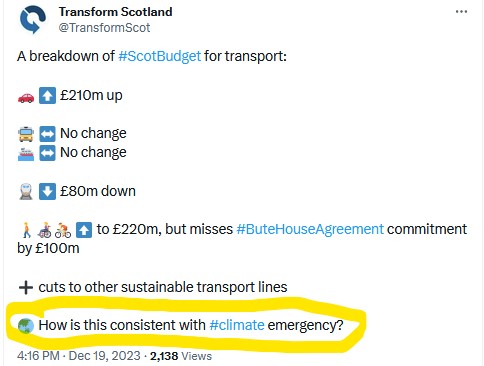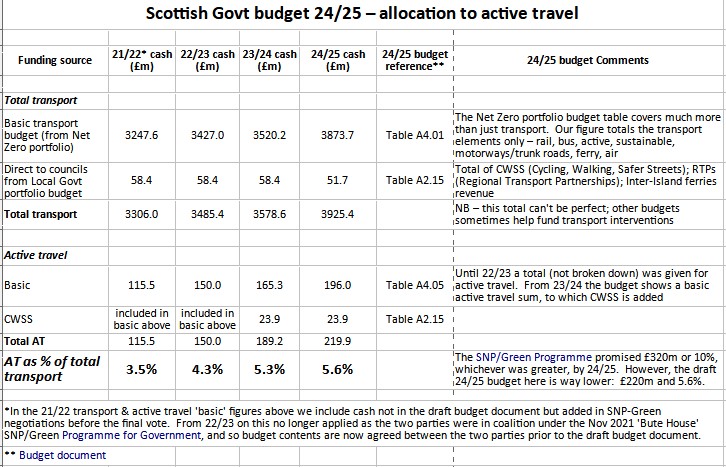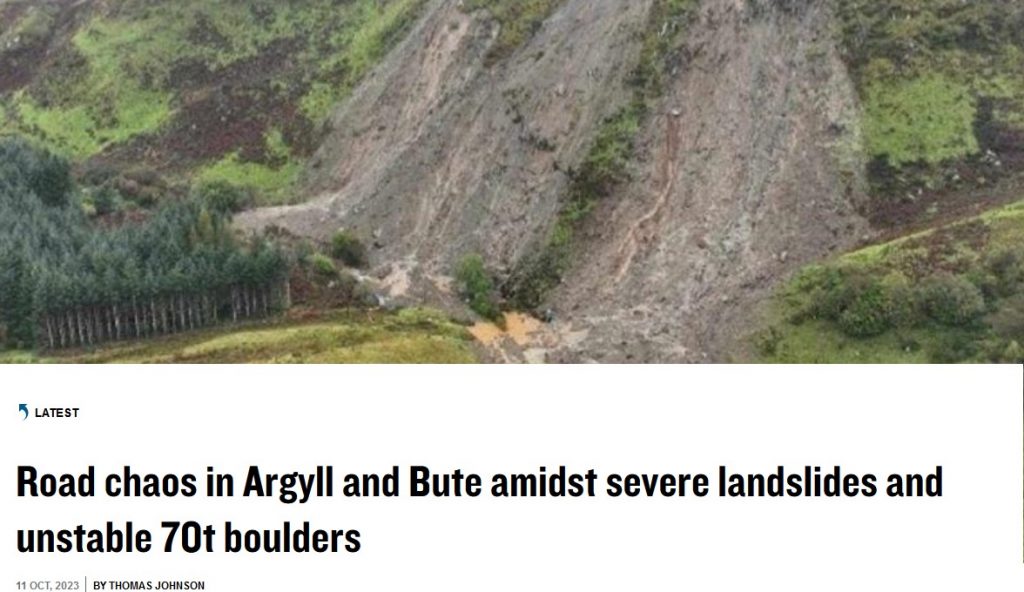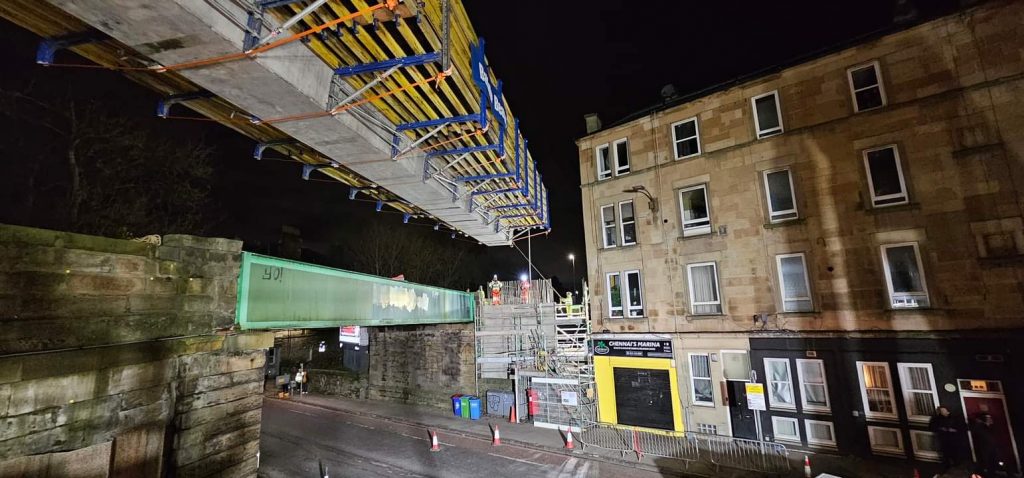Despite a rise in active travel funding in the draft budget, the overall transport picture was not what is needed in a climate emergency – and already transport is Scotland’s worst performing sector in terms of climate emissions. Indeed, the increase in trunk road cash (£210m) almost equals the total of active travel investment (£220m) whilst some other sustainable transport areas have seen significant cuts.
Update, early Jan 2024:
- Re the ‘Transformation Project‘ which is mentioned in the final section below (“How the Active Travel cash is used“), we have just come across this interesting link. As far as we know there has been no public announcement, and we came across it by chance. So the Active Travel Transformation Fund is now renamed the Active Travel Infrastructure Fund (ATIF). Whether this will entirely or only partially replace the Sustrans ‘Places for Everyone‘ fund (also mentioned below) in future we don’t know, although there have been hints that this may be so, at least for construction costs.
Transform Scotland summed up the budget position nicely in this tweet

Active Travel cash
The November 2021 SNP/Green joint Shared Policy Programme (the ‘Bute House’ agreement) included the superb promise that “by 2024-25 at least £320m or 10% of the total transport budget will be allocated to active travel.” That commitment has been repeated in numerous subsequent official documents [e.g. the Sept 2023 Programme for Government] and by Ministers up to and including this year.
Thus, although the draft 24/25 budget does bring a modest rise in active travel investment, the total remains way below the commitment. £220m instead of £320m; 5.6% instead of 10%.

Ever since 22/23 we been very concerned at the pattern of increases in active travel cash. To grow from £115m to £320m over 3 years should have seen rises of around £60-£70m a year, giving councils the ability to build up relevant staffing, skills, project planning, traffic orders, public awareness etc, and to deliver early projects. Instead, we saw far lower annual rises, implying a massive jump in 24/25 to achieve the £320m commitment; bringing problems for councils, belated project delivery and thus belated modal shift.
Nonetheless, and despite the Scottish Government grossly undershooting its commitment, active travel cash has increased considerably in recent years, almost doubling since 21/22, and is now around £40 per person – way ahead of England (£10 or, apparently, after recent cuts, £1) and Wales (£22), although not Ireland (~£50) and several other European countries. Of course, Scotland is at present far behind many of its European neighbours in terms of cycling infrastructure, and so consistent investment at a high level is vital.
Rapid transition from private motor traffic to getting around more on foot and by bike, as well as by public and shared transport, is vital in an era of climate crisis, let alone for public health at a time of high obesity levels and falling life expectancy.
UK Climate Change Committee
The CCC has a duty to report annually on the progress of the Scottish Government towards meeting its legally binding climate targets. The CCC was criticised in the past for being too weak in its analysis of implementation of the Scottish Government’s targets (not least in transport) whilst praising their ambition in setting tough targets. Their most recent report on Scottish progress [December 2022] however, was very different … a tough report and a particularly tough public presentation of it.
- “We are running out of time; we are not on track … it is magical thinking” said Chris Stark, Chief Exec of the CCC
Transport in particular is falling badly behind, and is on course to get worse. And, within transport, the commitment to a 20% car-km reduction by 2030 is “significantly off track.” We discussed this further in our 23/24 budget report.
Other transport budget changes
Trunk Roads cash rises from £801m to £1,011m (table A4.06 in the budget document). The largest part of the rise (from £373m to £525m) is in ‘Safety & Maintenance,’ which presumably reflects increasing climate-related damage (landslides, surface erosion, etc). Obviously maintenance and repair are crucial but, ironically, the increased traffic resulting from trunk road capacity increases elsewhere will contribute to emissions and thus to further climate-related damage and costs. Depreciation costs also rise, by £40m to £210m, due in part to higher traffic volumes and worsening roads condition, and £134m goes in interest payments for previous privately financed road capacity increases.
The carbon assessment table accompanying the budget classes roughly 75% of Trunk Road expenditure as “highly negative” for climate emissions.

Bus support is largely unchanged [table A4.04] but overall rail funding is cut by £80m, from £1681m to £1601m [table A4.03] – in both cases with some aspects up and others down.
Two less prominent budget lines (and thus easier to cut), the Future Transport Fund, Low Carbon (FTFLC) and Support for Sustainable Travel (SST) have been on a very severe downward slide in this and last year’s budgets. FTFLC, down from £130m in 22/23, to £99m in 23/24, and just £36m in 24/25, covered a variety of projects to reduce transport emissions, such as in rail freight, low-emission buses and urban transport (with greater reliance now on private cash). SST, down from £17m in 22/23, to £7m in 23/24, and just £4.5m in 24/25, supported various transport behaviour change initiatives, though some of this continues under the main active travel budget.
Where does the active travel cash increase come from?
Active travel cash in the budget increases by about £30m, from roughly £189m to £220m. Where does this increase come from? Obviously much juggling occurs in a transport budget of £3900m+ covering everything from rail to road to ferries, some of which can involve large shifts from year to year. With a £210m increase in the trunk roads budget, however, it obviously does not come from there! But, as discussed in the previous paragraph, FTFLC is being cut by £63m from last year, and SST by around £3m, which more than pays for the £30m active travel rise.
In other words, the AT rise can be seen as merely a transfer from one sustainable transport budget line to another – and leaving a spare £36m of former sustainable transport cash to help pay for the increased trunk road spending!
How the Active Travel cash is used
The budget, as usual, gives little detail about how the AT cash will be used – this gradually emerges over the weeks and months.
The CWSS (Cycling Walking Safer Streets) element, £23.9m, goes to all Councils on a per-capita basis; they do not have to put in bids for it. Councils can, if they wish, use this money as match-funding when applying to Sustrans Places for Everyone support, thus doubling, or more, its value.

The bulk of the AT cash, £196m, appears in a budget line called Support for Active Travel (table A4.05). The spreadsheet of ‘Level 4’ budget information breaks this down a little further ..
- £160m (only a small rise from last year’s £152m) will go to capital investment, such as the Places for Everyone scheme run by Sustrans Scotland, where councils and others can bid for AT project cash, large or small – and/or to new government funding mechanisms as a result of the Active Travel Transformation Project.
- £36m (a huge rise from last year’s £12m) will be ‘current grant’ for active travel promotion and other non-infrastructure schemes.
No further details on how the money will be used are provided – many decisions on allocation of the funding are taken as the year progresses. In particular, no reason for the increased emphasis on behaviour change work is given. Secondly, and despite several requests, we (and perhaps councils?) are still somewhat in the dark about the government’s ‘Transformation Project‘ which is starting to deliver capital investment cash direct to Councils rather than via Sustrans – we discussed this further in our post about the Programme for Government.
[Jan 2024] We have just discovered, indirectly, that the 24/25 Transformation Fund has been announced to Councils etc, though there has been no public announcement that we know of. Its name has been changed to the Active Travel Infrastructure Fund (ATIF) 2024/25. The application page is also rather unusual; in particular we can see no information about criteria for the fund, amounts available, etc, other than a list of the types of projects that might qualify.
Other information
- Scotsman article on the active travel budget cash, by Alastair Dalton
- The final budget vote was on 27.2.24. Transform Scotland did this post-budget summary. We don’t think there was any change in the amounts we have quoted above, but have not checked.
What you can do following the draft budget announcement
- Contact MSPs … At Scotland level, due to the SNP/Green coalition having an overall majority, it is unlikely that the draft budget will change before the final vote on it in the new year. However, many MSPs will not be fully aware of the budget’s transport details, and you can help educate yours! Send us any interesting replies. There is also a question of what happens in the future – the May 2026 Scottish Parliament election is starting to enter political minds, and sustainable transport needs to be prominent.
- Contact councillors [Edinburgh / Other councils] … For councils, the budget means growing amounts of cash to bid for through the Places for Everyone scheme (and possibly new routes via the government Transformation Project) in 2024/25. Every council also automatically receives CWSS cash (explained above) which can be used as match funding when bidding to Sustrans. So ask your councillors to be ambitious – and to ensure they are building up the skilled staff needed for planning and delivery as available capital funding increases.
- Retweet our tweet of this article – thanks!
